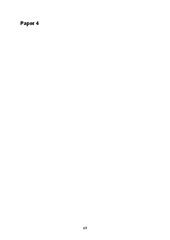| dc.contributor.advisor | Mollnes, Tom Eirik | |
| dc.contributor.author | Skjeflo, Espen Waage | |
| dc.date.accessioned | 2017-11-16T09:26:22Z | |
| dc.date.available | 2017-11-16T09:26:22Z | |
| dc.date.issued | 2017-11-28 | |
| dc.description.abstract | Sepsis is a syndrome of life-threatening organ malfunction caused by a dysregulated host response to infection. The complement, kallikrein/kinin, coagulation and fibrinolysis plasma cascade systems as well as the TLR system recognize and initiate the immediate responses to infection and thus play an important role in the development of sepsis. In this regard, the ubiquitous TLR co-receptor, CD14, as well as C5 have been identified as upstream, bottle-neck targets to attenuate the response to infection. S. aureus is the most common cause of Gram-positive sepsis whereas E. coli is the most common cause of Gram-negative sepsis. Both bacteria activate complement and coagulation, and are recognized by TLRs in human whole blood, triggering the release of inflammatory cytokines, markers of coagulation activation and markers of leukocyte activation. In turn, combined inhibition of complement and CD14 efficiently reduced these responses to S. aureus and E. coli in a human, whole blood model. Furthermore, in a randomized, controlled trial of combined CD14 and C5 inhibition (treatment) versus saline (control) in porcine polymicrobial sepsis, treatment significantly improved survival
Preemptive, combined inhibition of CD14 and C5 thus emerges as a potential anti-inflammatory regimen in both S. aureus and E. coli bacteremia. | en_US |
| dc.description.doctoraltype | ph.d. | en_US |
| dc.description.popularabstract | Sepsis (blood poisoning) is caused by a dysregulated bodily response to infection. Overactivation of the innate immune system is in this regard an important initiating process in the development of sepsis. Bacteria are recognized by cells and proteins in the blood, such as the complement system and white blood cells. Their subsequent activation results in contradictory signals both triggering inflammation and reducing it. Septic patients are therefore in risk of both developing life-threatening multi-organ failure from too much inflammation and of not being able to fight the underlying infection because of too little inflammation. The aim of this thesis was to explore the possibility of reducing the initial reaction to the bacteria by modulating how complement and immune cells recognize the bacteria. We first added reagents that interfered with two key activation pathways of complement and immune cells, before we tested this treatment in a clinically relevant animal model of sepsis. It turned out that both the immune reaction in human whole blood was attenuated and that the treated animals had a greater rate of survival than untreated animals. We therefore concluded that this way of modulating the immune response could be an interesting approach to treat selected cases of bacteremia (bacteria in the blood) and sepsis. | en_US |
| dc.description.sponsorship | Helse Nord | en_US |
| dc.description | The papers 1, 2 and 3 of this thesis are not available in Munin. <br>
Paper 1: Skjeflo, E. W., Christiansen, D., Espevik, T., Nielsen, E. W., Mollnes, T. E.: “Combined Inhibition of Complement and CD14 Efficiently
Attenuated the Inflammatory Response Induced by Staphylococcus
aureus in a Human Whole Blood Model”. Available in <a href=http://doi.org/10.4049/jimmunol.1300755>
J Immunol. 2014, 192(6):2857–64. </a>
<br>
Paper 2: Skjeflo, E. W., Christiansen, D., Fure, H., Ludvigsen, J. K., Woodruff, T. M., Espevik, T., Nielsen, E. W., Brekke, O. L., Mollnes, T. E.: “Staphylococcus aureus-induced Complement Activation Promotes Tissue Factor-mediated Coagulation”. (Manuscript).
<br>
Paper 3: Skjeflo, E. W., Christiansen, D., Landsem, A., Steinvik, J., Woodruff, T. M., Espevik, T., Nielsen, E. W., Mollnes, T. E.: «C5aR1 and CD14 are Crucial for Phagocytosis of Live and Dead Escherichia coli and Staphylococcus aureus in Human Whole Blood”. (Manuscript).
<br> | en_US |
| dc.identifier.isbn | 978-82-7589-568-2 | |
| dc.identifier.uri | https://hdl.handle.net/10037/11749 | |
| dc.language.iso | eng | en_US |
| dc.publisher | UiT The Arctic University of Norway | en_US |
| dc.publisher | UiT Norges arktiske universitet | en_US |
| dc.rights.accessRights | openAccess | en_US |
| dc.rights.holder | Copyright 2017 The Author(s) | |
| dc.rights.uri | https://creativecommons.org/licenses/by-nc-sa/3.0 | en_US |
| dc.rights | Attribution-NonCommercial-ShareAlike 3.0 Unported (CC BY-NC-SA 3.0) | en_US |
| dc.subject | VDP::Medical disciplines: 700::Basic medical, dental and veterinary science disciplines: 710::Medical immunology: 716 | en_US |
| dc.subject | VDP::Medisinske Fag: 700::Basale medisinske, odontologiske og veterinærmedisinske fag: 710::Medisinsk immunologi: 716 | en_US |
| dc.title | Harnessing Innate Immunity - Complement and TLR Inhibition in Experimental Models of Gram Positive and Polymicrobial Bacteremia and Sepsis | en_US |
| dc.type | Doctoral thesis | en_US |
| dc.type | Doktorgradsavhandling | en_US |


 English
English norsk
norsk

